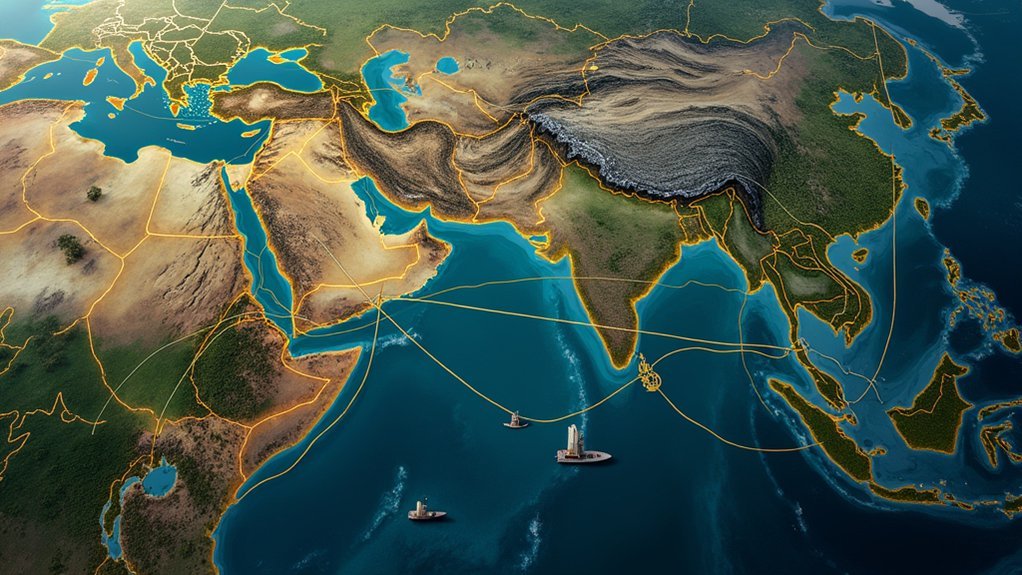You’ll find five major jewelry trade routes shaped our global adornment history. The Silk Road connected China to Mediterranean markets with jade and lapis lazuli. Phoenicians established maritime routes spreading luxury jewelry throughout the Mediterranean. The Trans-Saharan gold trade linked African wealth to northern markets. Southeast Asian gem routes distributed jade and precious stones worldwide. Colonial networks later revolutionized distribution, leading to modern jewelry houses. These pathways reveal how gems transformed cultures across continents.
The Silk Road: Precious Gems and Techniques Across Continents

While often celebrated for silk trading, the Silk Road served as a significant artery for gemstone commerce that reshaped the jewelry world from 200 BCE onward.
You’d find precious gems like jade, lapis lazuli, and turquoise traveling these extensive trade routes, connecting China to Mediterranean markets.
As you explore the history of these exchanges, you’ll discover that jewelry-making techniques flowed alongside the gemstones themselves, creating cross-cultural artistic influences that transformed craftsmanship across civilizations.
Marco Polo’s 13th-century accounts detailed vibrant gemstone markets that highlighted both the diversity and demand for these treasures.
Major cities such as Samarkand and Constantinople emerged as essential trading hubs, where merchants exchanged not just stones but ideas that blended into unique jewelry designs incorporating multiple cultural elements.
Mediterranean Maritime Routes: Phoenician and Roman Jewelry Networks
Long before the Silk Road reached its zenith, the Mediterranean Sea hosted its own vibrant network of jewelry exchange. The ancient Phoenicians established expansive maritime trade routes, connecting diverse cultures through the commerce of exquisite gemstones and precious metals.
- Phoenician merchants functioned as early luxury brands, distributing distinctive jewelry from ports like Tyre and Carthage throughout the Mediterranean basin.
- Roman Empire traders built upon these foundations, incorporating exotic materials from conquered territories into their intricate designs.
- Maritime trade routes enabled cultural exchange of metalworking and gemstone cutting techniques, particularly between Roman artisans and Eastern craftspeople.
- Archaeological evidence from Mediterranean shipwrecks reveals the extensive reach of these networks, documenting how jewelry styles and craftsmanship techniques spread across civilizations.
Trans-Saharan Gold Trade: Africa’s Influence on Global Adornment

For centuries, Africa’s ancient kingdoms established one of history’s most significant jewelry trade networks through the Trans-Saharan gold routes. These ancient trade routes connected sub-Saharan wealth to Mediterranean markets, with Berber traders using camel caravans to transport African gold northward.
| Empire | Period | Impact on Global Jewelry Markets |
|---|---|---|
| Ghana | 8th-12th century | Controlled Audaghost, dominated early gold trade |
| Mali | 13th-15th century | Mansa Musa’s wealth influenced Cairo markets |
| Songhai | 15th-16th century | Expanded trade networks across Sahara |
| Kanem-Bornu | 13th-19th century | Connected eastern routes with gold and silver |
| Morocco | 16th-19th century | Linked African precious stones to European markets |
You’ll find evidence of this legacy in Western currencies and artifacts like the 1375 Spanish map depicting Mali’s king holding gold—proof of Africa’s enduring influence on global adornment traditions.
The Spice and Gem Routes of Southeast Asia
Since the first century CE, Southeast Asia’s intricate network of maritime and overland paths has shaped the global jewelry landscape through its renowned Spice and Gem Routes.
These trade networks connected India, Arabia, and the Far East, transforming ports like Malacca and Sumatra into thriving commercial hubs.
You’ll discover how these routes facilitated remarkable cultural exchange that influenced global jewelry design:
- Precious gemstones like jade and turquoise traveled from Southeast Asia to Medieval Europe via Indian Ocean maritime passages.
- Burma and Thailand emerged as primary sources for rubies and diamonds sought as luxury items by global elites.
- The 15th-17th centuries saw European powers compete intensely to control these lucrative trade routes.
- Technological advancements in gem cutting and setting techniques spread along these pathways, influencing diverse civilizations.
Colonial Trade Networks and the Rise of Modern Jewelry Houses

While Southeast Asia dominated early gem trading, the landscape dramatically shifted when European powers established colonial trade networks in the 15th and 16th centuries.
Spain and Portugal controlled routes that brought precious metals from the Americas to Europe, transforming the jewelry market as gold and silver became available for aristocratic adornment.
The 19th century’s Industrial Revolution sparked another significant change with mass production techniques making jewelry accessible to the middle class.
This period saw the emergence of modern jewelry houses like Cartier and Tiffany & Co., which pioneered luxury jewelry design and sophisticated marketing strategies.
Simultaneously, South African diamond discoveries revolutionized the industry, with De Beers establishing dominance over global diamond trade through strategic control of supply chains and brilliant branding campaigns that continue to influence markets today.
Frequently Asked Questions
What Trade Route Was Gold Traded On?
Gold was traded on the Trans-Saharan trade routes. You’ll find these routes connected western and central Sudan with North Africa, where Berber traders used camels to transport this precious metal across the desert.
What Was the Major Trade Route?
You’d need to be more specific when asking about “the major trade route.” The Silk Road, Trans-Saharan routes, and Indian Ocean maritime networks were all major pathways that facilitated global jewelry and gemstone trade.
What Are the Four Major Trade Routes of the Ancient World?
You’ll find four key ancient trade routes: the Silk Road connecting China to the Mediterranean, the Incense Route linking Arabia to the Mediterranean, the Amber Road from Baltic to Mediterranean, and the Trans-Saharan routes across Africa.
What Were the Major Trade Routes in 1200?
In 1200, you’d find busy trade networks spanning the globe: the Silk Road connecting China to the Middle East, Indian Ocean maritime routes, Venetian pathways linking Europe with Eastern markets, and Trans-Saharan gold routes across Africa.
In Summary
You’ve explored how jewelry trade routes shaped our world’s adornment history. From the Silk Road’s cultural exchange to Mediterranean maritime networks, African gold trades, Southeast Asian gem routes, and colonial expansions—these pathways didn’t just move precious materials but transferred techniques and styles. Today’s jewelry traditions reflect these ancient connections, proving that what you wear links you to thousands of years of global trade history.





Leave a Reply